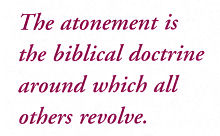INTRODUCTION
The Doctrine of Atonement
When taken to the hospital, the old herdsman was sick, blind, and dying.
While he was there his granddaughter came every day and read to him; the
old man enjoyed the soft sound of the child's voice. One day she found, in
the room, a Bible left by a friend. She casually opened to 1 John 1 and began
to read. He listened attentively, and when he heard the words "And the blood
of Jesus Christ his Son cleanseth us from all sin," he interrupted her.
 "Tell me," he said,
"is that really there?" "Tell me," he said,
"is that really there?"
"Yes, Grandpa, it's there."
"Could you read it to me again?"
" 'And the blood of Jesus Christ his Son cleanseth us from all sin.' "
For a few seconds there was silence; then he asked, "Are you quite sure that's
there, in that book?"
"Yes, Grandpa, quite sure."
"Please, take my hand and place my finger on that passage and read it to
me again." As she did it, tears dripped down from his sightless eyes, and
his voice was heard speaking with difficulty but with great assurance.
"My dear child . . . if anyone should ask you how I died, please tell them
that I died . . . cleansed."
What this story shows is that the doctrine of atonement is not an abstract
theory of salvation; it is, rather, the saving power of God in the lives
of fallen, sinful beings.
What is atonement? In general, it could be said that the word atonement refers
to the removal of any hindrance to fellowship with God. In a sense, atonement
is the equivalent of reconciliation, but it also includes the idea of expiation,
a fancy word that portrays the idea of removing any barrier that exists between
God and us. The doctrine of atonement emphasizes the sacrifice of Christ
as the exclusive expiatory means by which the barrier between us and
God—which is sin—is removed, leaving us reconciled to Him.
The atonement, in fact, is the biblical doctrine around which all others
revolve. It is centered in Christ's life, death, resurrection, ascension,
mediation, and return. It presupposes the presence of sin, our fundamental
and desperate need of salvation, and God's loving disposition to save us.
A proper understanding of the biblical doctrine of God is also indispensable
for understanding the atonement. It was God's love that made it possible
to restore us to union and fellowship with Him through Jesus Christ. We should
never give the impression that the death of Christ was needed in order to
persuade God to love us. God sent Christ to die for us because He already
loved us. The biblical doctrine of atonement is grounded in God's love for
sinful and rebellious creatures.
The fullness of the benefits of the atonement is enjoyed only by those who,
after being touched by the Holy Spirit, accept God's offer of salvation in
Christ as the exclusive means of forgiveness and reconciliation. Their hearts
are possessed by love and gratitude to God and Christ for this infinite
sacrifice.
Thus, it's our sincere hope that this quarter, as you study the meaning of
Christ's substitutionary sacrifice, you will be moved toward a greater commitment
to the One who suffered so much for us, so that whether you live or die,
you can, like the old herdsman, do so in peace.
Dr. Ángel M. Rodríguez, a native of Puerto Rico, is the
director of the Biblical Research Institute at the General Conference
headquarters, Silver Spring, Maryland.
Contents:
(all lessons may
not be
posted)
Giardina Sabbath
School Study Helps
Jerry Giardina of Pecos, Texas, assisted by his wife, Cheryl,
prepares a series of helps to accompany the Sabbath School lesson. He includes
all related scripture and most EGW quotations. Jerry has chosen the "New
King James Version" of the scriptures this quarter. It is used with permission.
The study helps are provided in three wordprocessing versions
Wordperfect; Microsoft
Word; RTF for our MAC friends (this
is now a zip file); and HTML (Web Pages).
Last updated on November 10, 2008
Editorial Office:
12501 Old Columbia Pike, Silver Spring, MD 20904.
Principal Contributor
Angel Manuel Rodriguez
Editor
Clifford R. Goldstein
Associate Editor
Soraya Homayouni Parish
Publication Managers
Lea Alexander Greve |
Editorial Assistants
Tresa Beard
Pacific Press Coordinator
Paul A. Hey
Art and Design
Lars Justinen
Concept Design
Dever Design |
Copyright © 2008 by the Office of the Adult Bible Study
Guide, General Conference of Seventh-day Adventist. All Rights Reserved.
SSNET Web Site Home page
Directory of Sabbath School
Bible Study materials
Archive of previous Adult
Sabbath School Bible Study Guides
Prepared for the Internet by the .
|